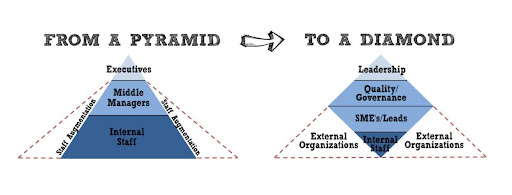Shine Bright like a Diamond – A New Form of Leadership

Leadership is something you hear about constantly – whether it’s how to be a leader, why leadership matters, and what it actually is. The vast amount of leadership quotes hanging in corporate offices, peppered throughout in educational programs, and blanketed across social media attests to its enduring interest and importance to those that are leaders and those that aspire to be one.
My work with leaders over the last few decades has seen a subtle, but powerful shift in what organisations look like and how they are led.
Diamond Leadership
Our organisations are no longer pyramids, but diamonds.
Source: Outsourcing – All You Need to Know, Cullen et al, 2014.
Pyramid structures are heavily populated with employees, most of whom are at the bottom of the pile. Diamond-shaped organisations replace the heavy bottom of the pyramid with third party providers. The benefits of the diamond include lower costs, greater agility, access to providers with best-of-breed skills and products.
Leadership of diamond-shaped organisations is different from the typical management narrative of a single individual who inspires and influences others. The difference is that it takes effective leadership pairings between the buy-side and sell-side, not a sole leadership figure. And leadership pairing between the parties is not just at the top, it needs to cascade through the formal bi-party hierarchy and include opinion leaders as well.
Strategic relationships are typically governed by operating committees and steering groups. A lot of effort can go into defining these structures and the related management processes. But the people selected to lead are more important than the structures erected to govern. Even more important, is the creation of effective leadership pairs.
The leadership pair is tasked with acculturation, whereby two or more organisational cultures merge to form a cohesive high-performing hybrid culture. In practice, leadership pairing is required at middle, as well as top, management levels because modern commercial relationships are full of adaptive challenges that require experiments, discoveries, adjustments, and innovations from many different parts of the organisations involved.
Unique Qualities in High-Performance Leadership Pairs
Effective leadership pairs consistently display the following behaviours and attitudes:
- Spirit of togetherness – The pair presents a united front to stakeholders in their respective organisations. Saying one thing in public and other in private doesn’t occur.
- Focus on the future – The leadership pair focuses on where they want the relationship to go, not where the relationship was.
- Transparency – The pair is open and honest about issues, not just to each other, but to all and sundry.
- Action-oriented – The pair isn’t afraid to use their powers – they act swiftly to remove, or workaround, obstructions from people, processes, or contracts.
- Problem solving – The pair seeks to diagnose and fix problems; they don’t seek to assign blame.
- Outcomes first – The pair does what’s best for the client, then ensures fair remuneration for the provider, and always produces a fair agreement.
As a result of all of these behaviours and attitudes, the leadership pairs are secure and confident in each other’s good will, intentions, and competency, thus creating earned trust. It is trust in the leadership that Australians seek first and foremost.
Australian Leadership Pairs
We’ve seen notable examples of high-performance leadership pairs in local politics in high performing pairs of Prime Minister and Treasurer; namely Hawk-Keating and Howard-Costello. Their common agenda, shared vision, and trust in each other’s capabilities demonstrably overshadowed personality clashes (albeit the latter seems to grab attention). We see it in local companies, particularly newer wildly successful businesses such as Mike Cannon-Brookes and Scott Farquhar at Atlassian and Andrew and Paul Bassat at SEEK.
Leadership pairing is in our collective consciousness. With little thought, you will be able to name many – in your community, at your workplace, and with your professional network.
Lead Horizontally, Not Just Vertically
Although the solitary hero mythology is perennial and embodied in much of Australia’s early legends, it is not the model for the future. In the old world of pyramids, a leader at the top inspiring and commanding subjects may have been acceptable. No longer. Australia is interconnected to the rest of the world, hierarchies are flat, and organisations are diamond-shaped.
Leaders today must be able to harness ideas and resources across boundaries and build strong connections outside their organisation. Australian businesses and Government cannot survive without their providers. More important is to harness the value of these connections and relationships – leading horizontally as well vertically. Those who do not, or cannot, will disappear like the pharaohs of old.
This article was written by Dr Sara Cullen, Managing Director, The Cullen Group.
Dr Sara Cullen will next be joining The Faculty Roundtable Program on 23rd April for a masterclass on genuine leadership that transforms relationships and enhances your approach to contract management, ensuring that your arrangements not only meet but exceed the intended results. If you’re a Roundtable member, you can register for the masterclass here.
